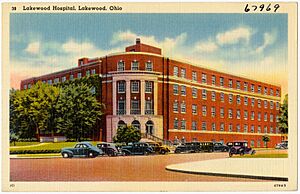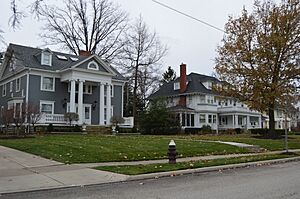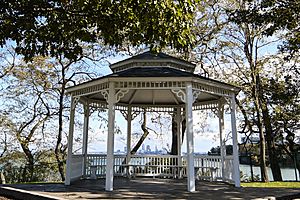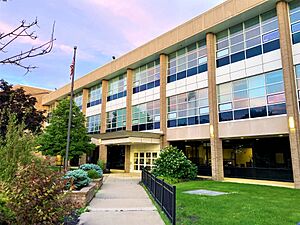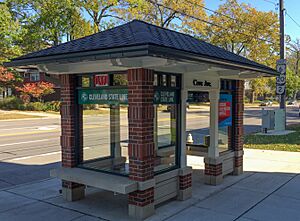Lakewood, Ohio facts for kids
Quick facts for kids
Lakewood, Ohio
|
|
|---|---|
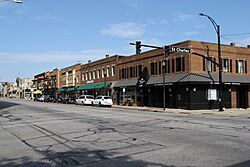
Lakewood Downtown Historic District
|
|
| Nickname(s):
City of Homes
|
|
| Motto(s):
"A Great Place to Call Home"
|
|
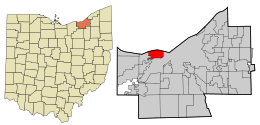
Location in Cuyahoga County and the state of Ohio.
|
|
| Country | |
| State | |
| County | Cuyahoga |
| Government | |
| • Type | Mayor-council |
| Area | |
| • Total | 6.70 sq mi (17.34 km2) |
| • Land | 5.54 sq mi (14.36 km2) |
| • Water | 1.15 sq mi (2.98 km2) |
| Elevation | 702 ft (214 m) |
| Population
(2020)
|
|
| • Total | 50,942 |
| • Density | 9,190.33/sq mi (3,548.69/km2) |
| Time zone | UTC−5 (Eastern (EST)) |
| • Summer (DST) | UTC−4 (EDT) |
| ZIP code |
44107
|
| Area code(s) | 216 |
| FIPS code | 39-41664 |
| GNIS feature ID | 1064966 |
Lakewood is a cool city in Cuyahoga County, Ohio, right on the southern shore of Lake Erie in the United States. It started way back in 1889. Lakewood is known as one of Cleveland's historic "streetcar suburbs," meaning people used to travel to and from Cleveland by streetcar! It's part of the bigger Cleveland area.
In 2020, about 50,942 people lived in Lakewood. This makes it the third largest city in Cuyahoga County, after Cleveland and Parma. Lakewood is often called the "City of Homes" and its motto is "A Great Place to Call Home."
Contents
History of Lakewood
How Lakewood Started
Before settlers arrived, the land that is now Lakewood was home to several Native American tribes. These included the Ottawa, Potawatomi, Chippewa, Wyandot, Munsee, Delaware, and Shawnee tribes. In 1805, a special agreement called the Treaty of Ft. Industry moved these tribes further west. This treaty allowed American settlers to move into the area.
In 1806, the land was officially surveyed and named Rockport Township. A group of six men bought it in 1807. The first permanent settlers, like James Nicholson, arrived from Connecticut in 1818. Early homes and farms were mostly along Detroit Avenue. This road was a toll road from 1848 to 1901.
Farming was a big part of life for early settlers. The land was great for growing fruit, and many vineyards appeared. Today, some street names like Orchard Grove and Blossom Park remind us of this history.
Growing into a City
Lakewood officially became a village in 1889. It was named "Lakewood" because it's right on the lake! In 1893, streetcars started running from Cleveland to Lakewood. This made it much easier for people to travel between the two places. More streetcar lines were added in 1903 and 1916.
As the community grew, more schools were needed. The school board decided to name new schools after Ohio's presidents. The Rocky River Railroad was built in 1869 to bring people from Cleveland to a resort area. This railroad line still exists today.
Lakewood was also home to two early car makers: Winton Motor Carriage Company (started in 1897) and Baker Motor Vehicle (started in 1899). By 1906, Baker Motor Vehicle was the biggest electric car maker in the world!
Modern Changes
In 2004, a new area called Rockport Square was built. It included homes along Detroit Avenue. Lakewood joined the Ohio Main Street Program in 2005. This program helps improve downtown areas.
Lakewood is also very good at recycling. It started curbside recycling in 1989. In 2009, Lakewood had one of the highest recycling rates in Ohio, at 79%!
Lakewood's Geography
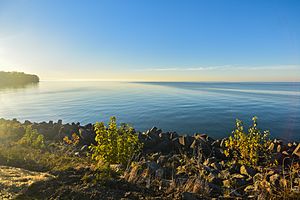
Lakewood is located about 6 miles (10 km) west of Downtown Cleveland. It borders Lake Erie to the north. To the east, it touches Cleveland neighborhoods like Edgewater. To the south, it borders Jefferson and Kamm's Corners. To the west, it borders the suburb of Rocky River at the Rocky River valley.
The city covers about 6.69 square miles (17.34 square kilometers). Most of this is land, with a smaller part being water from Lake Erie.
Lakewood's Neighborhoods
Lakewood has many historic homes. The "Make Lakewood Beautiful" program gives awards to homeowners who keep their houses looking like their original design. The city even offers tours of famous homes!
Here are some of Lakewood's neighborhoods:
- Arts District - This area is on the west side of Lakewood. It's centered around the Beck Center for the Arts.
- Birdtown - This unique neighborhood is in the southeast. It has eight streets named after birds! These houses were built in the 1890s for workers at the National Carbon Company. Birdtown became a National Register Historic District in 2006.
- Clifton Boulevard - This busy street has many large trees and different types of homes. You'll see multi-family homes, apartments, and older single-family houses.
- Clifton Park - This is one of Lakewood's wealthiest neighborhoods. It's in the northwest corner of the city. You can find many grand Victorian mansions here. It also includes the private Clifton Beach community.
- Downtown Lakewood - This is the main part of Lakewood. It's centered around Detroit Avenue and Warren Road. You'll find offices, restaurants, and shops here. The Lakewood Library and the post office are also in this area.
- The Edge - This eastern neighborhood has many places for concerts, pubs, and taverns.
- Victorian Village - This area is named for its large Victorian homes. They were built in the early 1900s for executives from the National Carbon Company.
- The Gold Coast - This area on the northeast side of Lakewood has many tall apartment buildings right by Lake Erie.
- Rockport Square - This is a newer development on the eastern side of the city. It includes condos and lofts.
- West End - This is the westernmost neighborhood. It's next to the Rocky River Reservation.
People of Lakewood
| Historical population | |||
|---|---|---|---|
| Census | Pop. | %± | |
| 1900 | 3,355 | — | |
| 1910 | 15,181 | 352.5% | |
| 1920 | 41,732 | 174.9% | |
| 1930 | 70,509 | 69.0% | |
| 1940 | 69,160 | −1.9% | |
| 1950 | 68,071 | −1.6% | |
| 1960 | 66,154 | −2.8% | |
| 1970 | 70,173 | 6.1% | |
| 1980 | 61,963 | −11.7% | |
| 1990 | 59,718 | −3.6% | |
| 2000 | 56,646 | −5.1% | |
| 2010 | 52,131 | −8.0% | |
| 2020 | 50,942 | −2.3% | |
| Sources: | |||
In 2010, there were 52,131 people living in Lakewood. About 87.5% of the people were White, and 6.4% were African American. About 4.1% of the population was Hispanic or Latino.
The average age in Lakewood was 35.4 years old. About 19.6% of residents were under 18. Many people in Lakewood have gone to college. About 39% of people over 25 have a bachelor's degree or higher.
Different Cultures in Lakewood
Lakewood is a diverse city with people from many different backgrounds. You'll find people with roots from Albania, Germany, Hungary, Ireland, Italy, Mexico, Poland, Russia, and Ukraine, among others.
In 2019, about 12.2% of people spoke a language other than English at home. These languages include Arabic, Spanish, Albanian, and Russian. Lakewood is a popular place for immigrants. Many new residents come from Southeast Europe, the Middle East, South Asia, and countries that were once part of the Soviet Union.
Economy and Jobs
Lakewood Hospital first opened in 1907. The city of Lakewood bought the hospital in 1931. In 2006, the Cleveland Clinic took over the hospital. In 2015, the Cleveland Clinic decided to close the hospital and build a new family medical center instead.
The new medical center opened in 2018. It offers outpatient programs, an emergency department, and wellness services. All 845 employees from the old hospital were offered other jobs within the Cleveland Clinic system.
Other businesses based in Lakewood include Geiger's, a clothing and ski equipment store that started in 1932. Malley's Chocolates, a famous chocolate company, also has its home in Lakewood. Aladdin's Eatery, a national restaurant chain, started its first restaurant in Lakewood in 1994.
Arts and Culture
The Lakewood Public Library is very popular and has won many awards. It has a main branch on Detroit Avenue and a smaller branch on Madison Avenue. The main library expanded in 2008 and now has over 474,000 items! The Madison branch was renovated and reopened in 2022.
The Lakewood Civic Auditorium is a large performing arts venue with 2,000 seats. It opened in 1955 at Lakewood High School. The front of the auditorium features a huge ceramic sculpture called Early Settler, made by Viktor Schreckengost. People often call it "Johnny Appleseed" because that's what the design is about.
The Beck Center for the Arts is the biggest cultural arts center on Cleveland's west side. It offers many different art programs and performances.
Parks and Recreation
Lakewood Park is one of the largest parks along Lake Erie in Ohio. It has a stage for live concerts, an outdoor swimming pool, and picnic areas. There's also a playground for kids, baseball fields, volleyball courts, and a skate park that opened in 2004. Lakewood has over 150 acres (0.61 km2) of green space throughout the city.
The park's lakefront promenade opened in 2006. It offers amazing views of Downtown Cleveland. You can even use viewing telescopes to see the city better! A path that goes around the whole park was also built in 2006.
In 2015, Lakewood opened its "Solstice Steps" in the park. These steps are built so that they line up with the sunset on the longest day of the year, the summer solstice.
The Rocky River Reservation, part of the Cleveland Metroparks System, is on the city's western border. The Lakewood Dog Park, built in 2004, is located next to the Metroparks.
Education in Lakewood
Public Schools
The Lakewood City School District is run by a school board that people vote for. In 2013, the Ohio Department of Education said the Lakewood City Schools had "Continuous Improvement." The city has rebuilt or renovated its high school, two middle schools, and seven elementary schools. This big project was finished in 2017. It was the first major school building program in Lakewood since 1920! The school system is one of the biggest employers in Lakewood.
The public schools include:
- Emerson, Grant, Harrison, Hayes, Horace Mann, Lincoln, and Roosevelt elementary schools (grades Pre-K to 5).
- Garfield and Harding middle schools (grades 6 to 8).
- Lakewood High School (grades 9 to 12).
Private Schools
Lakewood also has several private schools:
- Lakewood Catholic Academy (grades K-8) started in 2005. It brought together four Catholic elementary schools.
- St. Edward High School is a high school for boys (grades 9-12).
- Padre Pio Academy is a K-12 school.
- Lakewood Lutheran School offers elementary education (grades K-8).
Colleges
For higher education, Lakewood has The North Coast College. This college focuses on graphic and fashion design.
Media
You can find out what's happening in Lakewood through local newspapers and online news. These include The Sun Post-Herald and The Lakewood Observer.
Transportation
The Greater Cleveland Regional Transit Authority (RTA) has bus routes that run through Lakewood. Routes 55, 55B, and 55C run along Clifton Boulevard. They go to Cleveland State University in downtown Cleveland and to other suburbs like North Olmsted and Westlake. Other RTA routes serve Detroit Avenue, Warren Road, West 117th Street, and Madison Avenue.
There are also two RTA rapid transit stations very close to the Lakewood/Cleveland border. These stations connect to the Red Line. You can take the Red Line east to Downtown Cleveland or west to Cleveland Hopkins International Airport.
I-90 runs along the south side of Lakewood. It has exits at West 117th Street, Bunts Road, Warren Road, and McKinley Road. The Cleveland Memorial Shoreway is also nearby. It helps people travel to and from downtown Cleveland.
Lakewood is also a great city for bicycles. It has special "share the road" paths for bikes.
Famous People from Lakewood
Many notable people have connections to Lakewood!
Born in Lakewood
- Richard Celeste: He was the Governor of Ohio from 1983 to 1990. He also led the Peace Corps.
- Teri Garr: A well-known actress, singer, and comedian.
- Brian Hoyer: A professional football quarterback.
- Seán Patrick O'Malley: A Roman Catholic Cardinal and Archbishop of Boston.
- Benjamin Orr: The singer and bassist for the famous band The Cars.
Lived in Lakewood
- Mike Douglas: A popular singer and talk show host.
- Jimmie Foxx: A professional baseball player who is in the National Baseball Hall of Fame.
- Mike Hegan: A professional baseball player and broadcaster for the Cleveland Indians.
- John Lithgow: A famous actor.
- Burgess Meredith: Another well-known actor.
- Jack Buck: A famous sportscaster who is in the National Baseball Hall of Fame. He graduated from Lakewood High in 1942.
See also
 In Spanish: Lakewood (Ohio) para niños
In Spanish: Lakewood (Ohio) para niños


